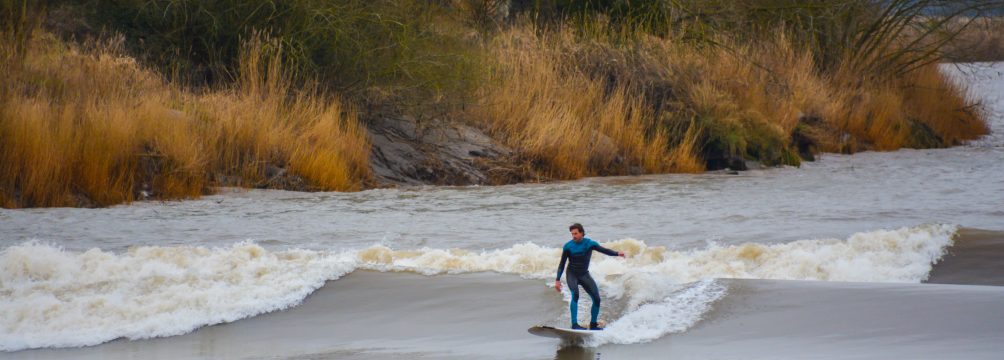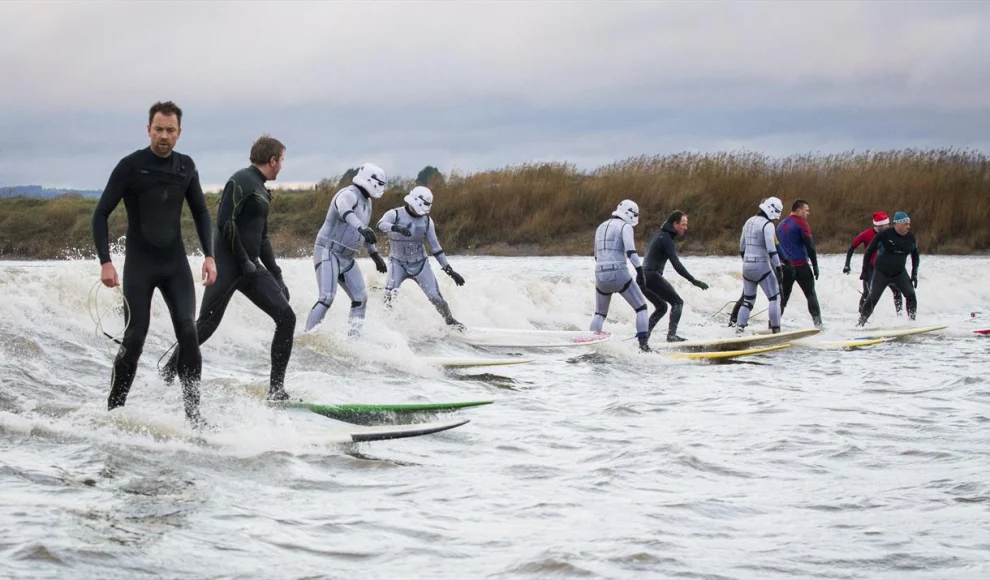DUE to its geographical location, surfing has always had a steady popularity in Wales, and one wave in particular – the Severn Bore – provides perhaps Wales’ greatest surfing thrill.
The Severn Estuary, which empties into the Bristol Channel, has one of the largest tidal ranges in the world – about 13m. It is exceeded only by the Bay of Fundy, and possibly Ungava Bay, both in Canada.
The tidal wave starts far out in mid-ocean. It moves towards the continent of Europe at about 700miles wide. When it reaches the continental shelf, its width decreases to about 200 miles wide, and its amplitude increases.
Approaching the Bristol Channel, a segment of the wave has to accommodate to the ever-decreasing width by raising its height. When it reaches the Severn proper, its width has decreased from 100mi or so to less than 5mi, and its height is nearly 15m.
As the bed of the estuary starts to rise and the sides continue to converge, the bore forms and begins to surge up the river in a tidal stream. The front edge of the wave is steep and the trailing edge flatter.
The bore consists of three or four sizeable waves followed by a few of diminishing size.
As with other waves, the wave tends to break in shallow places and near the bank, and flow smoothly in deep water. The wave travels upstream against the river current at a speed of 8 to 13 mph.
In the lower, broader part of the estuary near Avonmouth, the tidal surge advances as a slight roll in the deepwater channels and the water rapidly spreads across the sands and mudbanks.
Often, the Severn Bore floods the lower village of Pill if flood defences are not closed.

Past Sharpness, the bore begins to form and when it encounters the large left-handed bend at Hock Cliff, it crashes headlong into the rocks. Reforming, it runs up-river close to the Overton shore before crossing the estuary towards Box Cliff.
As it rounds the Horseshoe Bend it keeps to the outside but it afterwards moves across to the eastern side of the river.
Above Longney Sands, the river abruptly narrows to a hundred yards, the sands diminish and the channel occupies the whole of the river.
Now the bore is recognisably the spectacular phenomenon that people expect rather than a swelling flood of water.
From Minsterworth to Gloucester, the width of the river varies little and the bore continues unhindered, climbing the banks on the outer side of bends and breaking over shallow places.
At Lower Parting, close to Gloucester, it splits in two to pass either side of Alney Island.
Both branches encounter and overcome weirs and rejoin at Upper Parting, and the much diminished bore continues upstream. In particularly high tides the water may overtop the weir at Tewkesbury, and even the foot of the weir at Worcester may experience a rise in water level of a foot or so.
The largest bores occur around the times of the equinoxes but smaller ones can be seen throughout the year.
There are about 260 bores in each year occurring twice a day on 130 days. Because the bores are associated with the phases of the moon, one occurs between 7am. and noon on bore days, and the other between 7pm and midnight GMT, with the largest bores occurring between 9 and 11 in both the morning and evening.
Maximum bores occur between one and three days after new and full moons, and smaller ones on the days that precede and follow the maxima.
Timetables for the bore and predictions of bore heights are published each year, however, the heights and timings are subject to minor variations. The bore height is increased by a strong southwest or west wind, low barometric pressure, about 0.6m of fresh water below Gloucester and well-scoured channels in the estuary.
The height is decreased by strong winds from the east or north, high barometric pressure and little fresh water below Gloucester or excessive fresh water.
The bore is made earlier by strong southwest or west wind, low barometric pressure, between two and five feet of fresh water, and shorter and well-scoured channels in the estuary. Conversely, it is delayed by strong winds from the east or north, high barometric pressure, little fresh water and more meandering, poorly scoured channels.
The wind direction out at sea is of more significance than the local air-flow. Being the onset of the flood tide, the bore is accompanied by a rapid rise in water level which continues for about one and a half hours after the bore has passed.
The Severn bore is not a self-reinforcing solitary wave or soliton but rather a shock wave which is formed because the wave is travelling faster than the wave speed in water above the bore.
The passing of the bore causes a churning of the water, and the myriads of tiny bubbles popping contributes much of the roaring sound made by the bore.
The largest recorded bore was on 15th October 1966, when it reached a height of 2.8m at Stonebench.
The river was first surfed in 1955 by World War II veteran Jack Churchill, a Military Cross recipient renowned both for carrying a Scottish broadsword, and for being the only Allied soldier to kill an enemy with a longbow during the war.
He became a surfing enthusiast in his later life and rode the bore on a board he designed himself.
In September 2005, several hundred surfers gathered in Newnham on Severn to celebrate 50 years since the first recorded attempt at surfing the Severn bore and to view the première of Longwave by Donny Wright, a historical film documenting the evolution of the sport since its inception in 1955.
In March 2006, Steve King, a railway engineer from Gloucestershire, set a world record for the longest surfing ride on a river bore while riding the Severn bore; King surfed up the river for a distance of 7.6mi, a Guinness World Record.
On days when a large bore is expected, hundreds of surfing enthusiasts may accumulate, waiting for the waves to arrive. Hazards in high water conditions can include floating trees, collapsing portions of river bank, overhanging branches and even dead farm animals.
The Gloucester Harbour Trustees, as competent harbour authority for this part of the river, have issued safety guidance for surfers, canoeists, small craft and river bank users in relation to the bore.


















Add Comment